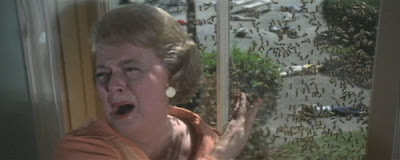The Swarm
 There's some dispute as to how to refer to the bees that feature in the hideously bad disaster flick The Swarm. Though they're generally described as "the Africans," one scientist insists that it's more accurate to call them "Brazilians." For they arrive in the United States by way of South America, and fly to Texas by crossing the Caribbean.
There's some dispute as to how to refer to the bees that feature in the hideously bad disaster flick The Swarm. Though they're generally described as "the Africans," one scientist insists that it's more accurate to call them "Brazilians." For they arrive in the United States by way of South America, and fly to Texas by crossing the Caribbean.In some ways these killer bees' precise origin doesn't matter: what counts is that they're foreign. The film goes to some lengths to distinguish them from native honey bees. Indeed, the reason why lead scientist Brad Crane (played by Michael Caine) refuses the military's suggestion to drop industrial supplies of pesticide upon the swarm is that the vital US bees would suffer unwanted collateral damage. He screams at the general: "The honey bee is vital to the environment. Every year in America they pollinate six billion dollars' worth of crops. If you kill the bee you're going to kill the crop. And if you kill the plant you kill the people. No! No, general!" And lest we miss the point (for Caine does a remarkable amount of shouting in this movie) and leave the cinema fearing bees of all kinds, the movie's final credit drives the point home:
THE AFRICAN KILLER BEE PORTRAYED IN THIS FILM BEARS ABSOLUTELY NO RELATIONSHIP TO THE INDUSTRIOUS, HARD-WORKING AMERICAN HONEY BEE TO WHICH WE ARE INDEBTED FOR POLLINATING VITAL CROPS THAT FEED OUR NATION.So the film makes it clear that these foreign bees pose a double threat: to the population at large, but especially perhaps to the industrious American worker.
The potential allegory is patent enough. A brown mass is poised just south of the border, and invades first the Southwest to overcome local residents by sheer force or numbers as well as their lethal but invisible venom, driving out hard-working citizens and installing themselves in their place. The threat first strikes the small-town life of a place such as the film's Marysville, with its hick ways, flower festivals, and touching love triangles between elderly bachelor and spinster schoolteacher. Even the old-fashioned virtues of summer picnics are at risk, because they're everywhere, faceless swarms with their unintelligible murmurs and crafty but unfathomable ways. Next the danger travels to the larger cities, such as Houston. By this time they're unstoppable: they're in the elevators and hallways, almost everywhere you turn.
Latin America is full of dangerous critters: anacondas, piranhas, even creatures from the haunted sea. But The Swarm suggests that the most pressing danger comes from the migrant hordes who slip across the border and infiltrate themselves into our everyday lives.
In the end Crane, side by side with his (rather unbelievable) lover interest Capt. Helena Anderson, hold off the tide at least for the time being. But the movie ends with the definite sense that there will be continued attempts to breach the southern border, and that if anything the next time it will only be worse. Because in fact they're already here, and they've been quietly reproducing: "The invasion didn't just now begin. They have been here for some time, breeding, increasing."

YouTube Link: the movie trailer.
Labels: border, geopolitics
